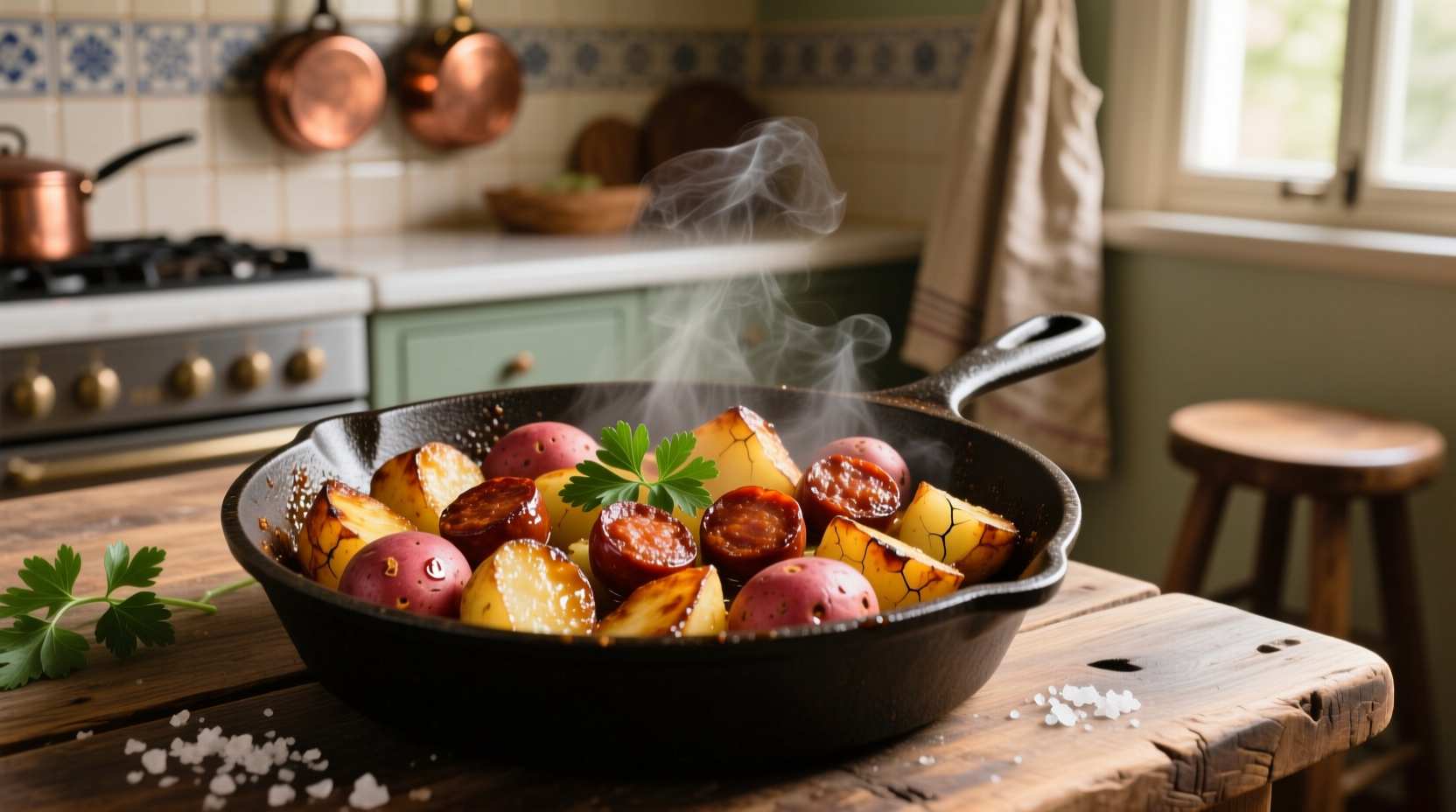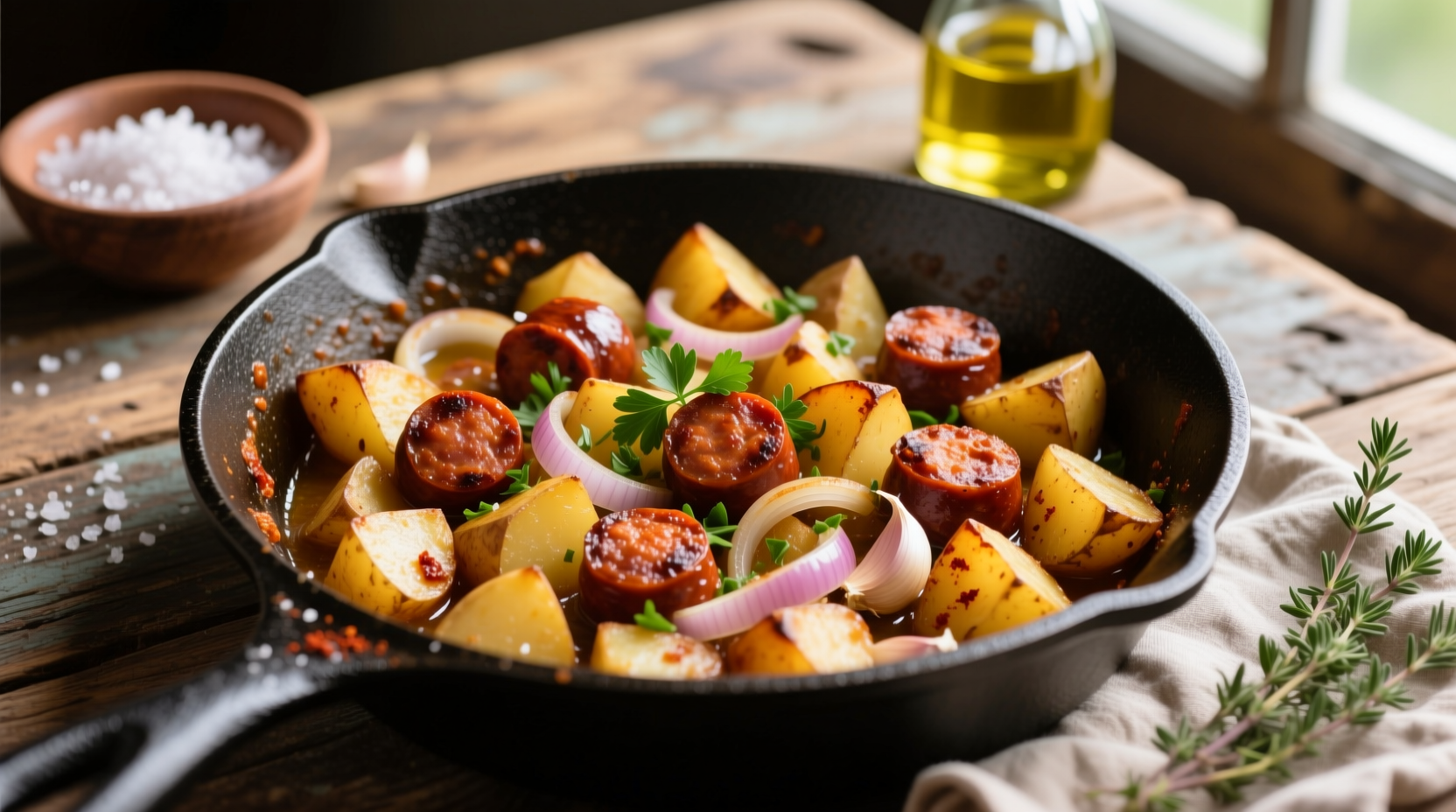Your Complete Guide to Authentic Chorizo Potatoes
Nothing beats the rich, smoky flavor of perfectly cooked chorizo potatoes—a classic Spanish tapas dish that's surprisingly simple to make at home. This authentic recipe delivers crispy potatoes with perfectly rendered chorizo, creating a harmonious blend of textures and flavors that will transport you to a Madrid tapas bar. Whether you're preparing a quick weeknight dinner or entertaining guests, this dish comes together in just 30 minutes with pantry staples and one special ingredient: quality Spanish chorizo.
Unlike many online recipes that use shortcuts or incorrect techniques, this guide provides the traditional preparation method used in Spanish kitchens, with clear explanations of why each step matters. You'll learn how to select the right chorizo, achieve the perfect potato texture, and avoid common mistakes that ruin this simple yet sophisticated dish.
The Foundation: Selecting Quality Ingredients
The magic of this dish lies in just three core components—potatoes, chorizo, and olive oil—but each requires careful selection for authentic results. Spanish chorizo isn't just sausage; it's a complex blend of pork, smoked paprika, garlic, and curing spices that varies significantly by region.
| Chorizo Type | Texture | Best For This Recipe | Where to Find |
|---|---|---|---|
| Chorizo Ibérico | Firm, sliceable | ★★★★★ Ideal (rich flavor) | Specialty markets, online |
| Chorizo de Pamplona | Semi-firm | ★★★★ Good (milder) | Latin grocery stores |
| Mexican Chorizo | Soft, crumbly | ★☆☆☆☆ Not recommended | Most supermarkets |
According to Spain's Ministry of Agriculture (mapa.gob.es), authentic Spanish chorizo must contain at least 60% pork and be cured for a minimum of 30 days. This curing process develops the complex flavor profile essential to this dish. For potatoes, choose waxy varieties like Yukon Gold or Charlotte that hold their shape during cooking.

Step-by-Step Cooking Method
Traditional Spanish cooks follow a specific sequence that maximizes flavor development while preventing common pitfalls like soggy potatoes or burnt chorizo. This method has been perfected over generations in tapas bars across Spain.
Preparation Phase (5 minutes)
- Peel and cut 1.5 lbs Yukon Gold potatoes into 1/2-inch cubes
- Slice 8 oz Spanish chorizo into 1/4-inch rounds
- Heat 3 tbsp extra virgin olive oil in a 12-inch cast iron skillet over medium heat
Cooking Phase (20 minutes)
- Add chorizo to cold oil (not hot) and cook slowly for 8-10 minutes until fat renders
- Remove chorizo with slotted spoon, leaving rendered fat in pan
- Add potatoes in single layer, seasoning with sea salt
- Cook 12-15 minutes, turning occasionally, until golden and crisp
- Return chorizo to pan, toss to combine, and cook 2 more minutes
The critical technique here is starting the chorizo in cold oil, which allows for gradual fat rendering without burning the exterior—a common mistake in many online recipes. This method, documented in traditional Spanish culinary texts like La Cocina Española Tradicional, ensures maximum flavor extraction from the chorizo while creating the perfect cooking medium for the potatoes.
Historical Context: From Spanish Taverns to Your Kitchen
Chorizo potatoes, known as "patatas a lo pobre" or "potatoes with chorizo," originated in 19th century Spain as an affordable tapas dish for working-class taverns. The recipe evolved from resourceful cooking techniques that made the most of available ingredients.
Evolution of Chorizo Potatoes
- 1800s: Emerged in Andalusian taverns as "patatas a lo pobre" (potatoes for the poor)
- Early 1900s: Spread to Madrid tapas bars with addition of cured chorizo
- 1950s: Became standard tapas menu item across Spain
- 1980s: Gained international popularity through Spanish tourism
- Today: Recognized as one of Spain's most beloved tapas dishes
This culinary evolution is documented by the Spanish Gastronomic Academy (realacademiagastronomia.org), which notes how regional variations developed based on local chorizo styles and potato availability. The version we know today—with cured Spanish chorizo—became standardized in the mid-20th century as transportation improved and regional ingredients became more widely available.
Adaptations for Modern Kitchens
While the traditional recipe shines in its simplicity, these thoughtful variations maintain authenticity while accommodating different dietary needs and preferences:
Dietary Adaptations
- Vegetarian option: Substitute mushroom "chorizo" made with smoked paprika and walnuts (simmer 8 oz sliced mushrooms in 2 tbsp olive oil with 1 tsp smoked paprika and 1 minced garlic clove for 10 minutes)
- Lower fat version: Use leaner chorizo varieties and reduce oil to 2 tbsp (note: traditional version relies on rendered fat for flavor)
- Gluten-free: Naturally gluten-free—just verify your chorizo brand (some contain fillers)
Flavor Enhancements
- Add 1 minced garlic clove during last 2 minutes of cooking
- Finish with fresh parsley and a squeeze of lemon
- For extra depth, add 1/4 cup dry sherry when returning chorizo to pan
Professional chefs note that the traditional recipe works best with minimal additions—the quality of your chorizo determines the final flavor profile. As documented in culinary research from Spain's Basque Culinary Center (bculinarycenter.com), adding too many ingredients disrupts the delicate balance that makes this dish special.
Serving Suggestions and Pairings
In Spain, this dish is typically served as a tapa with specific accompaniments that enhance the flavors without overwhelming them:
- Traditional presentation: Served in the same skillet it was cooked in, often with a sprig of rosemary
- Perfect pairings: A crisp Albariño white wine or a light Rioja rosé
- Side dishes: Simple green salad with sherry vinaigrette balances the richness
- When to serve: Ideal as a starter or light main course for lunch
Avoid serving with heavy sauces or strong flavors that compete with the chorizo's distinctive taste. The Spanish tradition emphasizes letting quality ingredients shine with minimal intervention—a principle documented by culinary historians at Madrid's Escuela de Hostelería.
Storage and Reheating Instructions
While best enjoyed fresh, leftovers can be stored properly for later enjoyment:
- Refrigeration: Store in airtight container for up to 3 days
- Reheating: Warm in skillet over medium-low heat (not microwave) to restore crispness
- Freezing: Not recommended—potatoes become mushy when frozen
- Reviving leftovers: Add 1 tsp olive oil when reheating to refresh texture
Food safety research from the European Food Safety Authority (efsa.europa.eu) confirms that properly stored cooked chorizo maintains quality for 3-4 days in the refrigerator. Always reheat to an internal temperature of 165°F (74°C) for safety.
Troubleshooting Common Issues
Even simple recipes can present challenges. Here's how to solve the most frequent problems:
| Problem | Why It Happens | Solution |
|---|---|---|
| Potatoes are soggy | Oil wasn't hot enough or overcrowded pan | Cook in batches; ensure oil shimmers before adding potatoes |
| Chorizo is burnt | Started cooking in hot oil or used high heat | Always start chorizo in cold oil; use medium-low heat |
| Dish is too greasy | Didn't drain excess fat after cooking chorizo | Remove chorizo and pour off all but 2 tbsp rendered fat |
Professional chefs emphasize that patience is key—rushing the cooking process by increasing heat leads to uneven results. The traditional Spanish method requires slow rendering of the chorizo fat to develop maximum flavor without burning.
Frequently Asked Questions
Can I use Mexican chorizo instead of Spanish chorizo?
Mexican chorizo is raw and requires different preparation, making it unsuitable for this recipe. Spanish chorizo is cured and ready to eat, which creates the proper texture and flavor. Using Mexican chorizo will result in a completely different dish with excess grease and different cooking requirements.
Why do you start chorizo in cold oil?
Starting chorizo in cold oil allows for gradual fat rendering without burning the exterior. This traditional Spanish technique maximizes flavor extraction while creating the perfect cooking medium for the potatoes. Adding chorizo to hot oil causes the exterior to burn before the fat renders properly.
How do I prevent my potatoes from sticking to the pan?
Ensure your pan is properly preheated and the oil is shimmering before adding potatoes. Use a well-seasoned cast iron or carbon steel skillet, which provides the best non-stick surface for this recipe. Avoid moving the potatoes too soon—let them develop a crust before turning.
Can I make this recipe in an air fryer?
While possible, air frying won't replicate the traditional texture. The rendered chorizo fat is essential for flavoring the potatoes in the authentic method. If using an air fryer, cook chorizo first to render fat, then toss potatoes in that fat before air frying at 380°F for 15-18 minutes, shaking occasionally.











 浙公网安备
33010002000092号
浙公网安备
33010002000092号 浙B2-20120091-4
浙B2-20120091-4